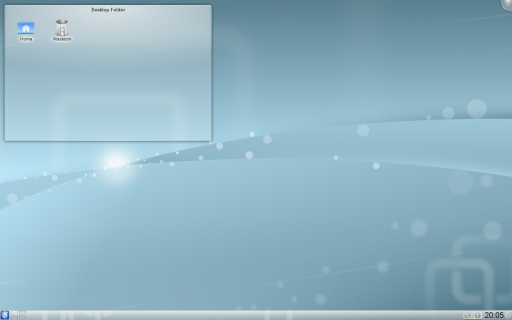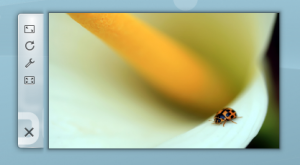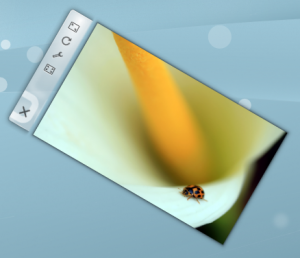Plasma/de: Difference between revisions
Updating to match new version of source page |
Updating to match new version of source page |
||
| Line 1: | Line 1: | ||
{{Template:I18n/Language Navigation Bar|Plasma/Introduction_to_Plasma}} | {{Template:I18n/Language Navigation Bar|Plasma/Introduction_to_Plasma}} | ||
<languages /> | <languages /> | ||
<span class="mw-translate-fuzzy"> | |||
==Plasma auf einem Blick== | ==Plasma auf einem Blick== | ||
</span> | |||
Ein typischer Plasma-Desktop sieht so aus: | Ein typischer Plasma-Desktop sieht so aus: | ||
| Line 13: | Line 10: | ||
[[Image:KDESC_Default_Desktop.png|512px|center]] | [[Image:KDESC_Default_Desktop.png|512px|center]] | ||
<span class="mw-translate-fuzzy"> | |||
Die drei Schlüsselkomponenten eines Plasma-Desktops sind: | Die drei Schlüsselkomponenten eines Plasma-Desktops sind: | ||
</span> | |||
<span class="mw-translate-fuzzy"> | <span class="mw-translate-fuzzy"> | ||
| Line 20: | Line 19: | ||
* '''Der Plasma-Werkzeugkasten''' in der oberen rechten Ecke des Bildschirms - auch bekannt als ''Cashew''. Ein analoger Button ist auch in der Leiste vorhanden. | * '''Der Plasma-Werkzeugkasten''' in der oberen rechten Ecke des Bildschirms - auch bekannt als ''Cashew''. Ein analoger Button ist auch in der Leiste vorhanden. | ||
</span> | </span> | ||
All of these default items are fully configurable and can host a wide variety of tools and content. | |||
<span class="mw-translate-fuzzy"> | |||
{{Info | Wenn du die Plasma-FAQ suchst, findest du die aktuelle Version [[Special:mylanguage/Plasma/FAQ | auf dieser Seite]].}} | |||
</span> | |||
A "Frequent Asked Questions" for the current version of the Plasma Desktop is maintained [[Special:mylanguage/Plasma/FAQ | on this page]]. It provides succinct answers to common questions as well as links to FAQs for older versions. | |||
===Sich in Plasma zurechtfinden=== | ===Sich in Plasma zurechtfinden=== | ||
<span class="mw-translate-fuzzy"> | |||
Man kann Plasma so benutzen, wie man den Desktop beliebiger anderer Betriebssysteme benutzen würde, indem man das Programm-Menü (K-Menü) aufruft, die aktuell geöffneten Programme in der Programmleiste ansieht, Dienstprogramme öffnet, und so weiter. | Man kann Plasma so benutzen, wie man den Desktop beliebiger anderer Betriebssysteme benutzen würde, indem man das Programm-Menü (K-Menü) aufruft, die aktuell geöffneten Programme in der Programmleiste ansieht, Dienstprogramme öffnet, und so weiter. | ||
</span> | |||
<span class="mw-translate-fuzzy"> | <span class="mw-translate-fuzzy"> | ||
| Line 33: | Line 42: | ||
</span> | </span> | ||
<span class="mw-translate-fuzzy"> | |||
===Desktop und Icons=== | ===Desktop und Icons=== | ||
</span> | |||
<span class="mw-translate-fuzzy"> | <span class="mw-translate-fuzzy"> | ||
| Line 39: | Line 50: | ||
</span> | </span> | ||
<span class="mw-translate-fuzzy"> | |||
* Man kann mehr als eine Ordner-Ansicht haben; | * Man kann mehr als eine Ordner-Ansicht haben; | ||
* Man kann die Ordner-Ansicht auch andere Verzeichnisse anzeigen lassen (sowohl lokal als auch im Netzwerk). | * Man kann die Ordner-Ansicht auch andere Verzeichnisse anzeigen lassen (sowohl lokal als auch im Netzwerk). | ||
</span> | |||
Folder View can also be set as the default full-screen desktop background for a more traditional "icons scattered on the desktop" layout. Visit the [[Plasma/FolderView|Folder View]] page to find out how to do this and much more with Folder View. | |||
=== Panels === | |||
[[Image:Panel_Settings.png|512px|center]] | |||
Panels allow you to place widgets around the edges of the screen. These collections of widgets can be configured in various ways, including making them automatically hide when not in use or aligned to certain areas of the screen. | |||
By default, there is one panel at the bottom of the screen, but you can add more panels, move and otherwise configure the default panel and remove panels you no long want. The widgets in all of the panels may also be adjusted to your liking. | |||
For more information on configuring panels in Plasma Desktop and what they are capable of doing for you, visit the [[Plasma/Panels|Plasma Panels]] page. | |||
<span class="mw-translate-fuzzy"> | <span class="mw-translate-fuzzy"> | ||
| Line 56: | Line 75: | ||
</span> | </span> | ||
Widgets that are docked into | Widgets that are docked into a panel usually have an Options menu, while those on the desktop have the configuration options within the 'handle', the shaded area which pops up when hovering over the widget. Clicking and holding the mouse on the blank part of the handle will allow you to drag the widget to the desired position. | ||
[[Image:Handle.png|300px|center]] | [[Image:Handle.png|300px|center]] | ||
You have four tools on this handle. The top one is the re-sizer. Click and | You have four tools on this handle. The top one is the re-sizer. Click and drag on the tool to resize the widget. | ||
The second tool is a rotate tool. Again, click and hold the tool, while rotating to desired angle. | The second tool is a rotate tool. Again, click and hold the tool, while rotating to the desired angle. | ||
[[Image:Handle_rotate.png|300px|center]] | [[Image:Handle_rotate.png|300px|center]] | ||
| Line 69: | Line 88: | ||
The third is the wrench or spanner which allows you to configure that particular widget's settings. | The third is the wrench or spanner which allows you to configure that particular widget's settings. | ||
Finally, the forth tool is | Finally, the forth tool is the "expanded view" tool and is available only on widgets that support this feature, such as the Picture Frame or Web viewers. When clicked, the Picture Frame widget will, for example, open the currently viewed in an image viewer while the Web Slice widget will open the web page in a full web browser window. | ||
A list of Plasma widgets with their own page can be found [http://userbase.kde.org/Category:Widgets here], and some of our favourite widgets are discussed on ''[[Plasma/Plasmoids|the Plasma Widgets page]]'' | |||
== | == Activities == | ||
=== Use Cases === | |||
A user likes web comics so they add their favorite web comics via the comics widget. The user now has a full desktop activity dedicated to their favorite web comics. Now the user is happy with the web comics, but the user now has to go to work, so the user creates a activity with the folder view widgets set to the folders of the projects the user is currently working on. After work the user goes home and works on a side project of writing romance novels. The user always gains inspiration by looking at pictures of the user's significant other. The user now creates a new Activity but now puts pictures frame widgets with pictures of the user's significant other. The user also has a folder view of the romance novel project folder. Now no matter what the user is doing the user has a custom tailored activity to match it. | |||
[ | Go to [http://hanswchen.wordpress.com/2009/11/17/how-do-you-use-activities/ this blog] to read a few tips on using activities. | ||
== | == Widget Layouts and Virtual Desktops == | ||
Virtual desktops, the ability to have a separate sets of windows on separate desktops, can tie in with Activities. You can have a different activity on each virtual desktop. In Plasma Desktop 4.4, this can be configured by entering System Settings and navigating to Desktop -> Multiple Desktops, and checking "Different Activity for Each Desktop". | Virtual desktops, the ability to have a separate sets of windows on separate desktops, can tie in with Activities. You can have a different activity on each virtual desktop. In Plasma Desktop 4.4, this can be configured by entering System Settings and navigating to Desktop -> Multiple Desktops, and checking "Different Activity for Each Desktop". | ||
In Plasma Desktop 4.3, You configure this by zooming out and choosing "configure Plasma". Then select "use a different activity on each desktop" and zoom in again. | In Plasma Desktop 4.3, You configure this by zooming out and choosing "configure Plasma". Then select "use a different activity on each desktop" and zoom in again. | ||
==Hints and Tips== | ==Hints and Tips== | ||
| Line 168: | Line 143: | ||
[[Category:Desktop]] | [[Category:Desktop]] | ||
[[Category:Plasma]] | |||
Revision as of 13:48, 25 August 2010
Template:I18n/Language Navigation Bar
Plasma auf einem Blick
Ein typischer Plasma-Desktop sieht so aus:

Die drei Schlüsselkomponenten eines Plasma-Desktops sind:
- Die Leiste mit dem Programm-Menü, der Liste an geöffneten Progammen, einer Uhr und den laufenden Dienstprogrammen;
- Der Desktop ist der Bereich, auf dem sich Miniprogramme (Symbole und Applets) befinden;
- Der Plasma-Werkzeugkasten in der oberen rechten Ecke des Bildschirms - auch bekannt als Cashew. Ein analoger Button ist auch in der Leiste vorhanden.
All of these default items are fully configurable and can host a wide variety of tools and content.
A "Frequent Asked Questions" for the current version of the Plasma Desktop is maintained on this page. It provides succinct answers to common questions as well as links to FAQs for older versions.
Sich in Plasma zurechtfinden
Man kann Plasma so benutzen, wie man den Desktop beliebiger anderer Betriebssysteme benutzen würde, indem man das Programm-Menü (K-Menü) aufruft, die aktuell geöffneten Programme in der Programmleiste ansieht, Dienstprogramme öffnet, und so weiter.
Ein wichtiger Teil Plasmas sind die sogenannten Widgets. Widgets sind die individuellen Einheiten des Desktops und beinhalten beispielsweise das Programm-Menü, Icons, den Dienstprogrammbereich, die Uhr... Widgets können entweder auf dem Desktop selber sein, oder in der Leiste liegen. Leisten und Desktops sind letztendlich nichts anderes als spezielle Widgets, die andere Widgets beinhalten können (in Plasma werden sie "Containments" genannt).
Wie geht das mit der Benutzung des Desktops zusammen? Plasma hat auch einige neue Funktionen, die die herkömmliche Desktop-Benutzung berücksichtigen. Wir haben die "Cashews" bereits erwähnt: Sie sind der Einstiegspunkt zur Kontrolle und Anpassung von Plasma. Indem man sie anklickt, öffnet sich ein Menü, das eine Reihe Möglichkeiten eröffnet: Widgets hinzufügen, in der Größe verändern, Leisten hinzufügen oder entfernen, sowies andere Operationen.
Desktop und Icons
Wie man vielleicht auf dem Screenshot gesehen hat, befinden sich keine Icons direkt auf dem Desktop. Stattdessen werden sie in einem Container platziert, auch bekannt als "Ordner-Ansicht" oder "Folder View". Obwohl es einige technische Gründe für dieses Vorgehen gibt, kann sich diese Ordner-Ansicht wie ein vollkommener Desktop-Ersatz verhalten. Man kann Icons hineinziehen, ausschneiden, kopieren, einfügen, Dateien umbenennen und auch neue Verzeichnise/Dateien erstellen.
- Man kann mehr als eine Ordner-Ansicht haben;
- Man kann die Ordner-Ansicht auch andere Verzeichnisse anzeigen lassen (sowohl lokal als auch im Netzwerk).
Folder View can also be set as the default full-screen desktop background for a more traditional "icons scattered on the desktop" layout. Visit the Folder View page to find out how to do this and much more with Folder View.
Panels

Panels allow you to place widgets around the edges of the screen. These collections of widgets can be configured in various ways, including making them automatically hide when not in use or aligned to certain areas of the screen.
By default, there is one panel at the bottom of the screen, but you can add more panels, move and otherwise configure the default panel and remove panels you no long want. The widgets in all of the panels may also be adjusted to your liking.
For more information on configuring panels in Plasma Desktop and what they are capable of doing for you, visit the Plasma Panels page.
Widgets überall
In KDE SC 4.x unterstützt Plasma nicht nur Widgets, die speziell für Plasma geschrieben wurden (auch bekannt als Plasmoide), sondern auch aus anderen Quellen, wie Google Gadgets and Dashboard Widgets aus Mac OSX. Zusätzliche Widgets können einfach über Get Hot New Stuff gefunden und installiert werden.
Widgets that are docked into a panel usually have an Options menu, while those on the desktop have the configuration options within the 'handle', the shaded area which pops up when hovering over the widget. Clicking and holding the mouse on the blank part of the handle will allow you to drag the widget to the desired position.

You have four tools on this handle. The top one is the re-sizer. Click and drag on the tool to resize the widget.
The second tool is a rotate tool. Again, click and hold the tool, while rotating to the desired angle.

The third is the wrench or spanner which allows you to configure that particular widget's settings.
Finally, the forth tool is the "expanded view" tool and is available only on widgets that support this feature, such as the Picture Frame or Web viewers. When clicked, the Picture Frame widget will, for example, open the currently viewed in an image viewer while the Web Slice widget will open the web page in a full web browser window.
A list of Plasma widgets with their own page can be found here, and some of our favourite widgets are discussed on the Plasma Widgets page
Activities
Use Cases
A user likes web comics so they add their favorite web comics via the comics widget. The user now has a full desktop activity dedicated to their favorite web comics. Now the user is happy with the web comics, but the user now has to go to work, so the user creates a activity with the folder view widgets set to the folders of the projects the user is currently working on. After work the user goes home and works on a side project of writing romance novels. The user always gains inspiration by looking at pictures of the user's significant other. The user now creates a new Activity but now puts pictures frame widgets with pictures of the user's significant other. The user also has a folder view of the romance novel project folder. Now no matter what the user is doing the user has a custom tailored activity to match it.
Go to this blog to read a few tips on using activities.
Widget Layouts and Virtual Desktops
Virtual desktops, the ability to have a separate sets of windows on separate desktops, can tie in with Activities. You can have a different activity on each virtual desktop. In Plasma Desktop 4.4, this can be configured by entering System Settings and navigating to Desktop -> Multiple Desktops, and checking "Different Activity for Each Desktop".
In Plasma Desktop 4.3, You configure this by zooming out and choosing "configure Plasma". Then select "use a different activity on each desktop" and zoom in again.
Hints and Tips
The Taskbar
Accessing the Taskbar Settings Menu: Click the panel toolbox (aka cashew), then right-click on the taskbar. From there you can access the Taskbar Settings dialog. The following settings are particularly useful:
- Grouping and Sorting: Grouping can be by program name, manually, or not at all. (You can also choose to only enable grouping if the taskbar is full.) Similarly, Sorting defaults to alphabetically, but it can also be by desktop, manually, or not sorted.
- Only Show Tasks from the Current Desktop: A checkbox on the Filters section.
- Have More than One Row on the Taskbar: If you use many applications at one time you may find it advantageous to set Maximum Rows and then Force Row Settings.
- Showing or Hiding Tooltips: A simple checkbox in the Appearance section of the General page.
Tweaking Plasma
- Learn how to add a sidebar with clock and news
- Customize your Plasma by mixing multiple Plasma themes
Weitere Informationen
* Die Plasma-FAQ
- Plasma HowTo - short screencasts
- Glossar
- Some of our favourite plamoids - why not add yours?
- Here's how to install more Plasmas widgets
- Learn the versatility of KRunner
| Back to the Introduction page |

